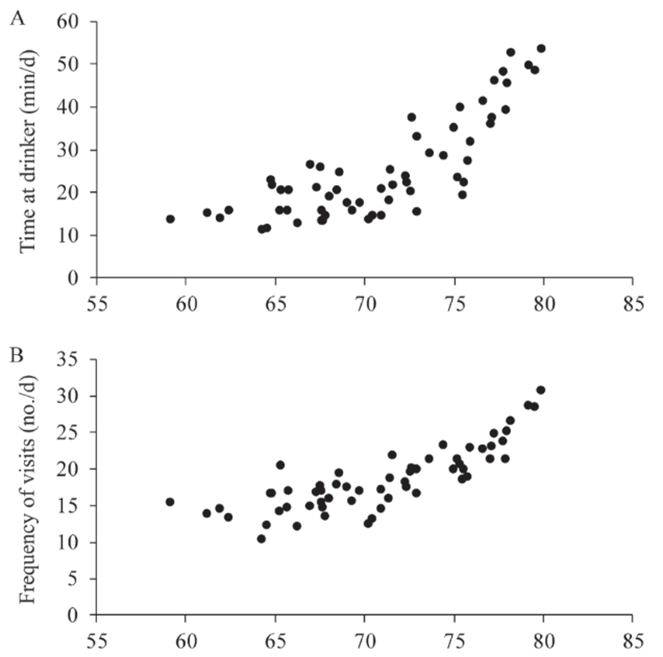Water is THE key nutrient for dairy cows with cows typically requiring 3-5kg of water for every kg of dry matter intake – that’s 70-115kg of water for a 35kg/day cow consuming 23kg dry matter and remember, she’ll consume up to 50% of it within an hour of milking!
This is why trough space (10cm per cow, 7.5cm deep (to allow muzzle to be submerged when drinking) and at least 10% of the herd to drink at once), and ‘refresh rate’ (the rate at which troughs refill) is so important. This is just as ‘standard’ and before we even consider the changes to water intake and drinking behaviour as temperatures rise as we head towards the summer, with increased demand, and increased competition at the drinker.
A study carried out at the University of British Columbia in Canada, looked at the points at which behaviours and intakes changed and found some quite striking changes, at relatively low THI levels.
Dairy cows show behavioural changes in order to cope with rising temperatures (being subject to ‘heat stress’). Agonistic social behaviour, such as competition, can occur over resources that aid in cooling, such as seeking shade and increasing water intake, but this work has only been done in pasture-based situations and not specifically around water intake.
The aim of this study was to evaluate how rising temperatures affect the behaviour of indoor-housed cows at the drinker.
In order to do this the researchers took 69 lactating Holstein dairy cows over the period June to August 2014 which were housed (without any form of heat abatement) in a mixed-parity group of 20 cows for 3 weeks after calving (cows entered at calving and left at around 3wks with new cows added as they calved) and milked 2x.
They measured water intake, frequency of drinker visits and time spent at the drinker (feed bins were also monitored to determine interaction) with temperature and relative humidity recorded at 1-h intervals at a weather station 500m from the barn.
General results averages
With increasing THI they observed
Time spent at the drinker and the number of competitive replacements at the drinker began to increase at a THI of 65 (approx. 19°C @ 60% RH).
Frequency of visits to the drinker began to increase at a THI of 64 (approx. 18.5°C @ 60% RH).

Note that the THI in this study was measured at a weather station and not in the barn (which may have been 2-4 THI points higher) but this study shows that drinking behaviour can be used to indicate when cows feel hot.
Water intake and drinking behaviour when the maximum THI over a 3-d period exceeded 65 (approx. 19°C @ 60-70% relative humidity) showed an increased time at the drinker and more displacement of other cows at the drinker.
Interestingly, water access requirements in summer for modern, high-yielding housed cows are linked to both intake and also the cooling effect of water. Passing air over water leads to evaporative cooling and may explain why frequency of visits rose so dramatically as THI increased without overall intake showing an equivalent increase. This means that not only do we need to allow sufficient drinker space for cows, but also be aware that the most pressure on those drinking spaces will occur following milking and typically in the time period 16.00-20.00 when daily THI peaks.
We know that the use of our immune modulation product OmniGen during periods of elevated THI and heat stress conditions can help lower both rectal temperature and respiration rate of cows. It also maintains dry matter intake and milk yields during heat stress conditions, and it has also been shown to reduce water intake in the same conditions. This can be helpful in reducing visits to the drinker and displacements as noted in this paper and can form a valuable tool in the approach to addressing heat stress in both milking and dry cows throughout the summer – contact your local Dairy Area Representative for more information or visit https://europe.pahc.com/challenges/heat-stress
Subscribe to our blog updates and receive new blog articles in your mailbox.
